Abstract
1. Experiments have been conducted on human subjects to determine the role of prediction in smooth eye movement control. Subjects were required to actively pursue a small target or stare passively at a larger display as it moved in the horizontal plane. 2. Target motion was basically periodic, but, after a random number of cycles an unexpected change was made in the amplitude, direction or frequency of target motion. Initially, the periodic stimulus took the form of a square waveform. In subsequent experiments, a triangular or sawtooth waveform was used, but in order to examine the timing of the response in relation to stimulus appearance, the target was tachistoscopically illuminated for 40-320 ms at the time that it passed through the mid-line position. 3. When subjects either actively pursued the target or stared passively at the larger display a characteristic pattern of steady-state eye movement was evoked composed of two phases, an initial build-up of eye velocity that reached a peak after 200 ms, followed by a decay phase with a time constant of 0.5-2 s. The build-up phase was initiated prior to target displacement for square-wave motion and before onset of target illumination for other waveforms. 4. The peak eye velocity evoked gradually increased over the first two to four cycles of repeated stimulation. Simultaneously, the response became more phase advanced, the reaction time between stimulus onset and the time at which peak velocity occurred decreasing from an average of 300 to 200 ms for triangular waveform stimuli. 5. When there was a sudden and unexpected change in amplitude and direction of the stimulus waveform, the eye movement induced had a peak velocity and direction that was inappropriate for the current visual stimulus, but which was highly correlated with the features of the preceding sequence in the stimulus. 6. When there was a sudden change in the frequency of the stimulus waveform the predictive eye movement was induced with a timing appropriate to the periodicity of the previous sequence but inappropriate to the new sequence. 7. The results indicate that prediction is carried out through the storage of information about both the magnitude and timing of eye velocity. The trajectory of the averaged eye velocity response was similar in form irrespective of the duration of target exposure or basic stimulus frequency, suggesting that the predictive estimate is released as a stereotyped volley of constant duration but varying magnitude under the control of a periodicity estimator.(ABSTRACT TRUNCATED AT 400 WORDS)
Full text
PDF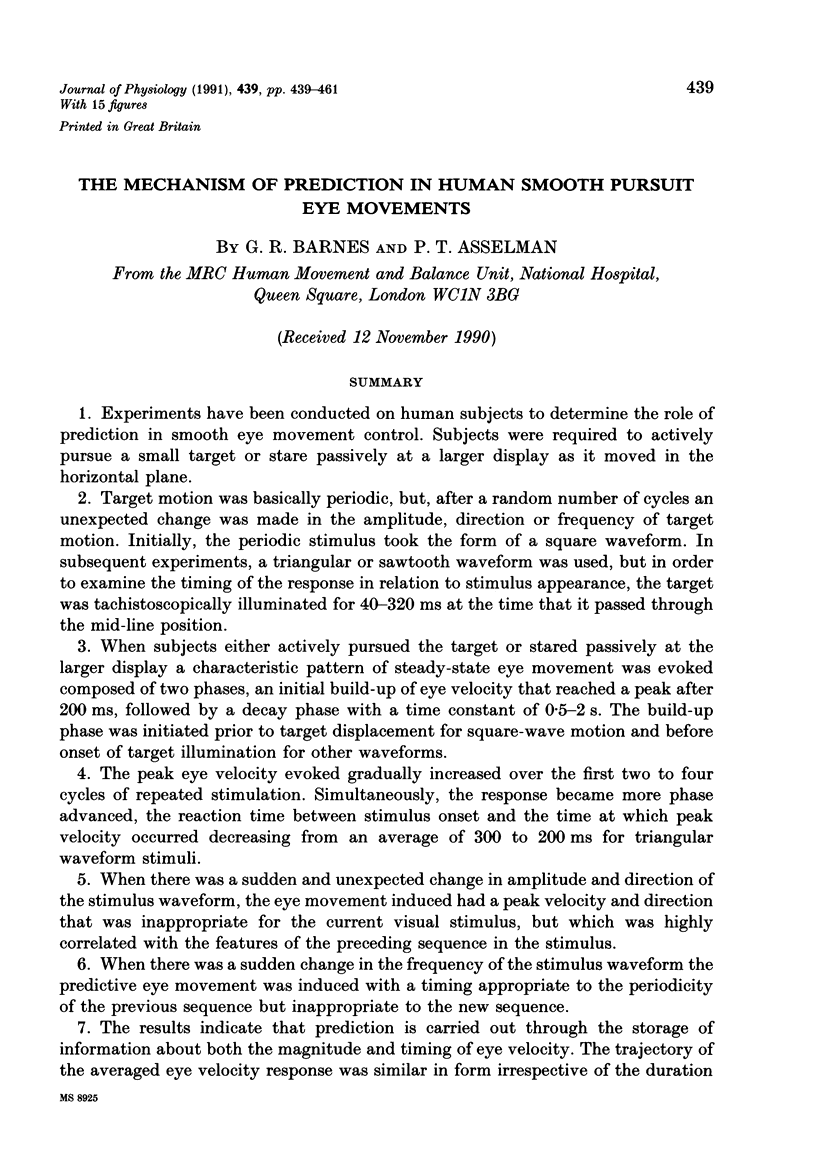
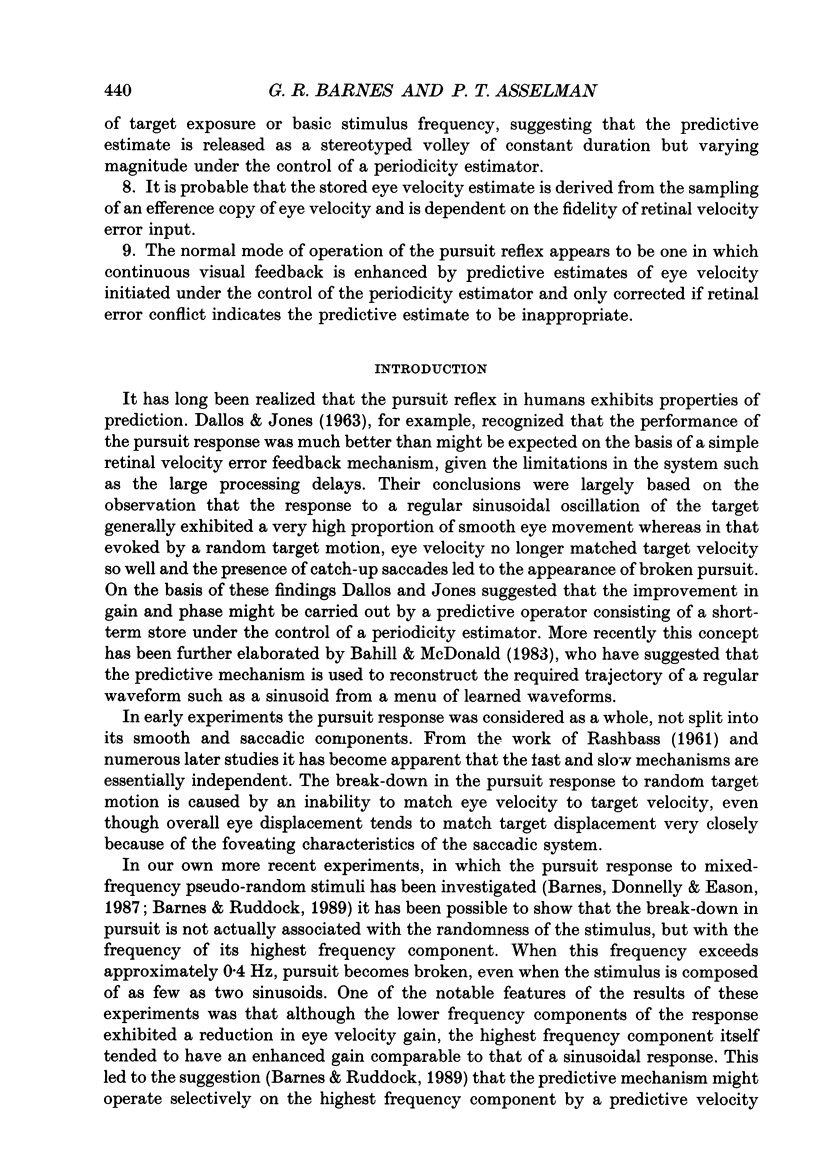

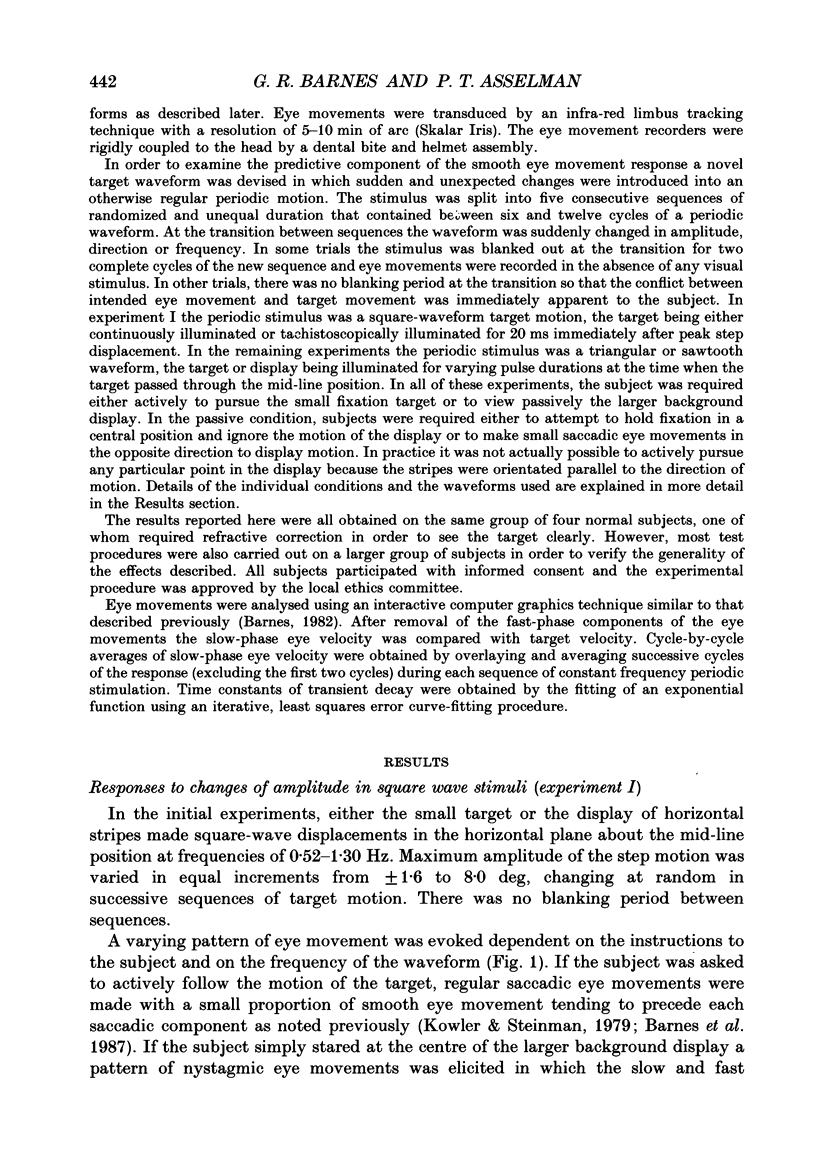

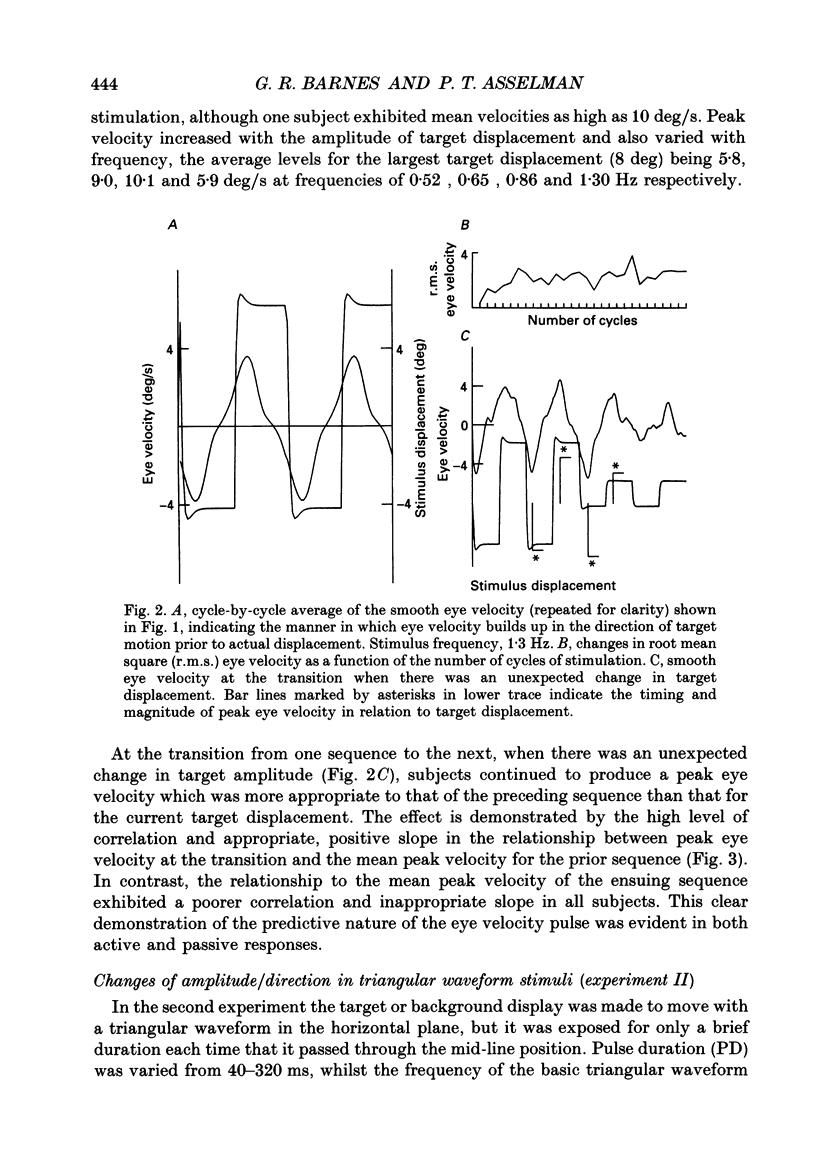
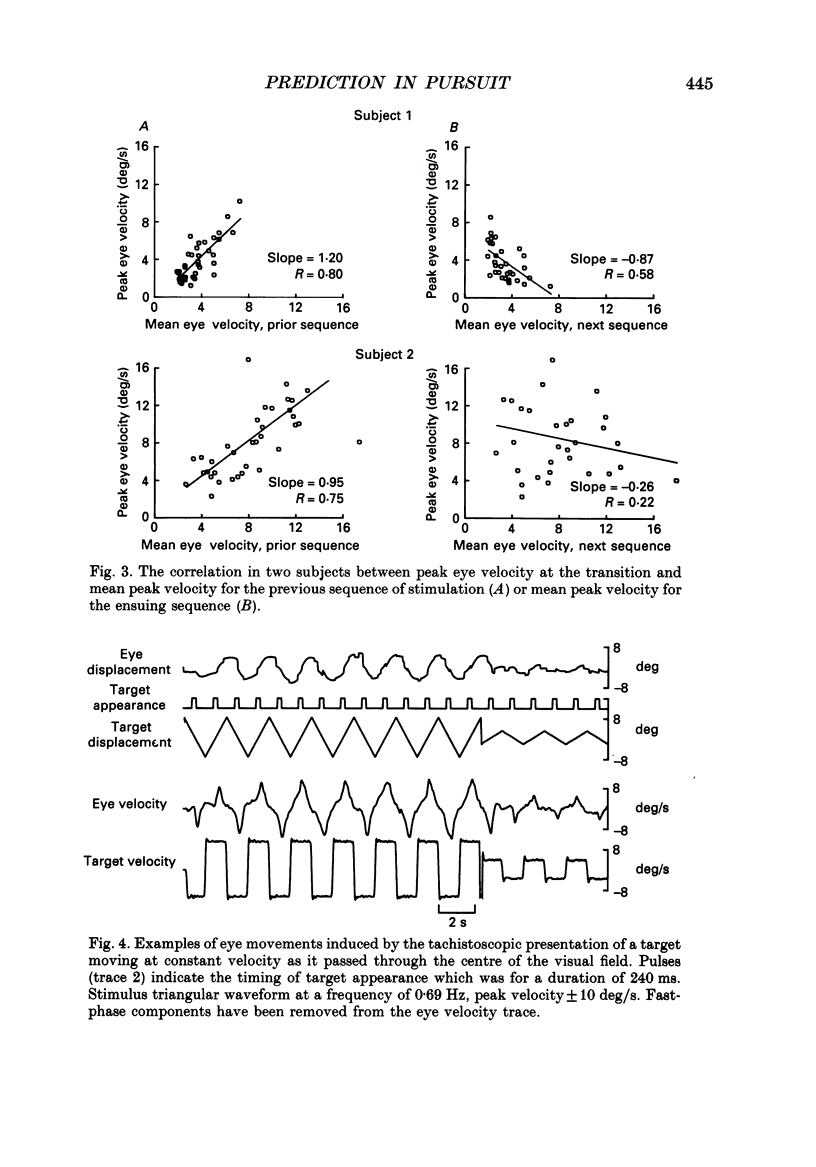
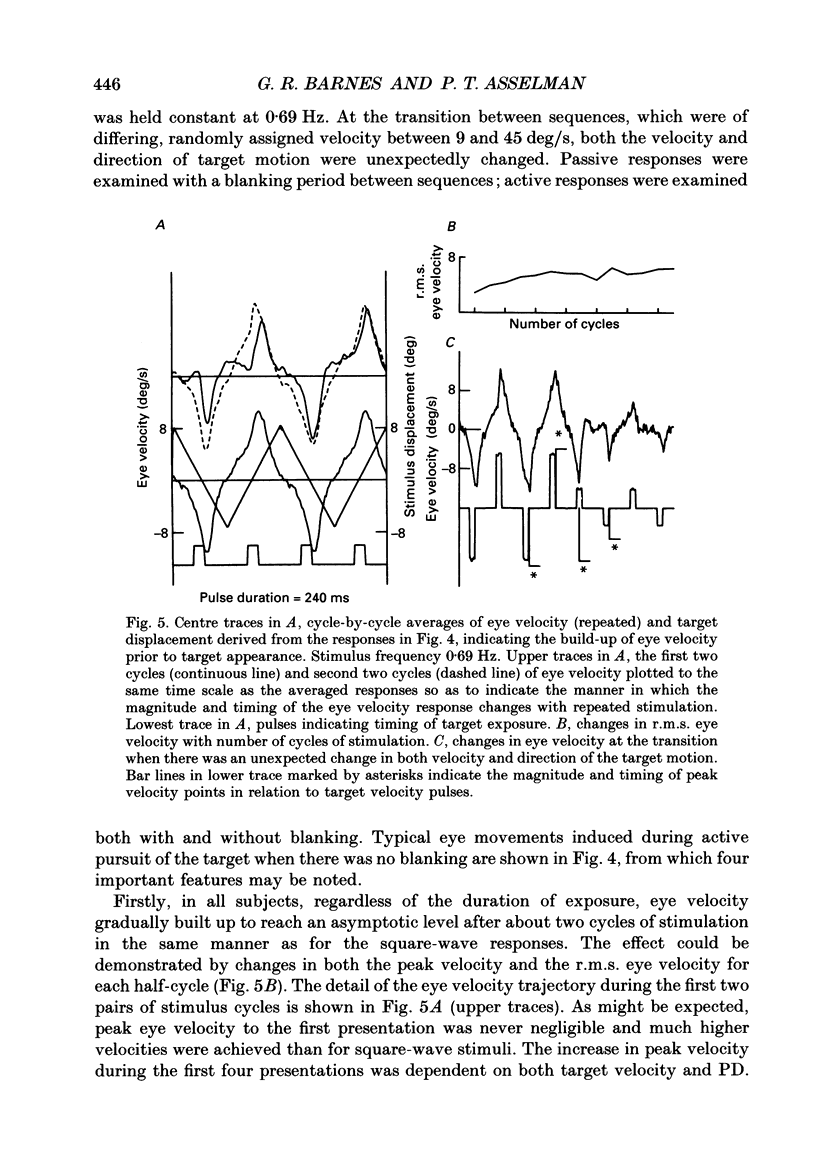
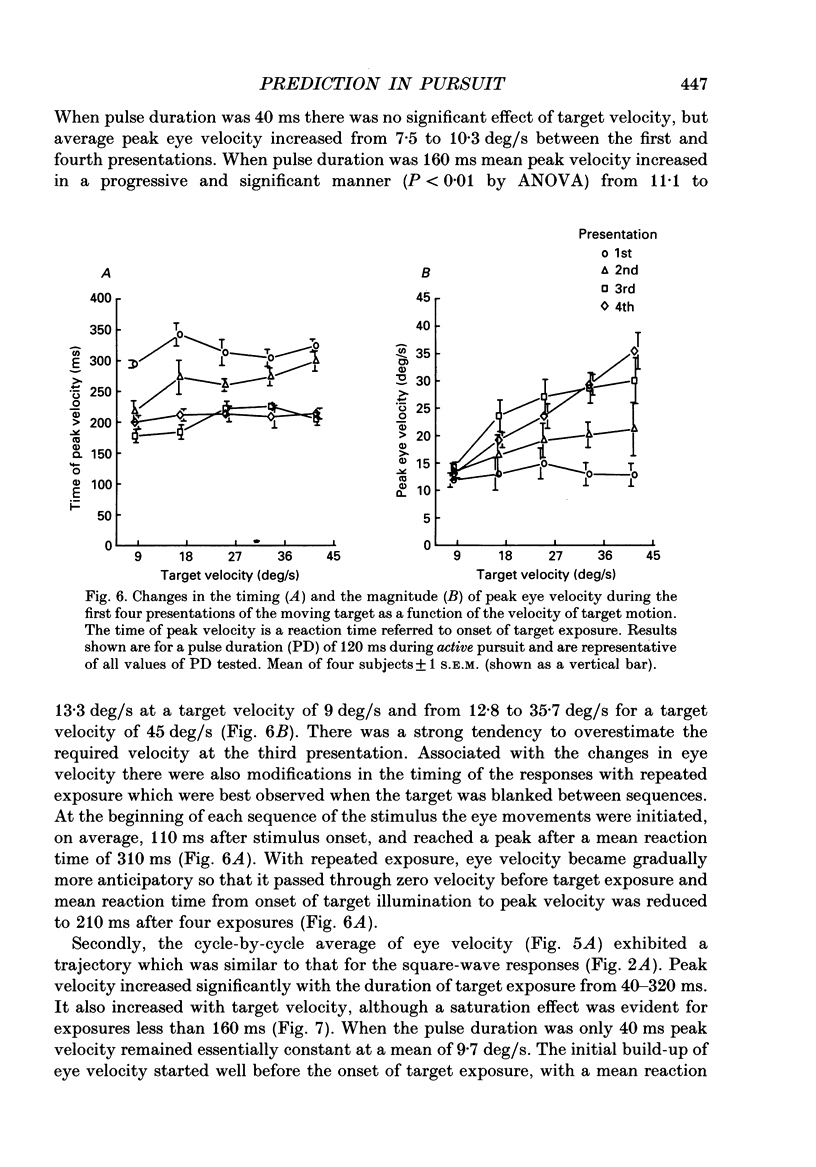
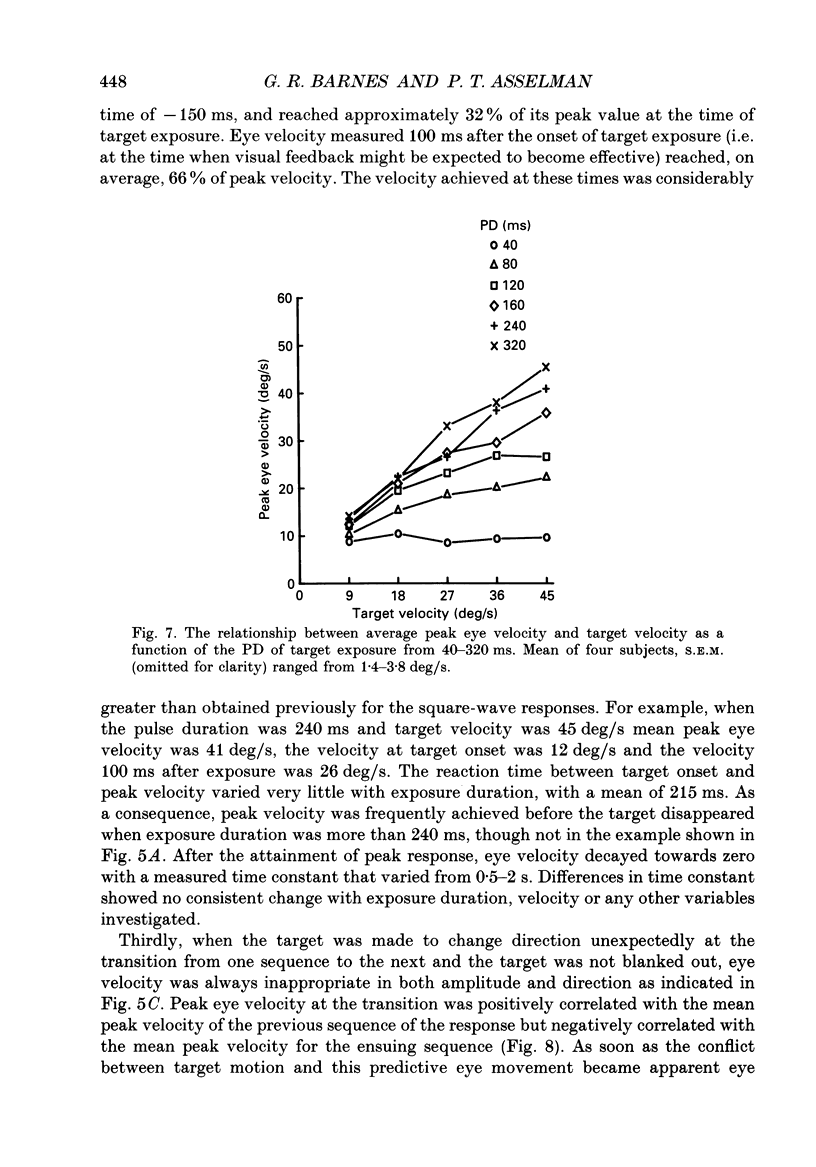
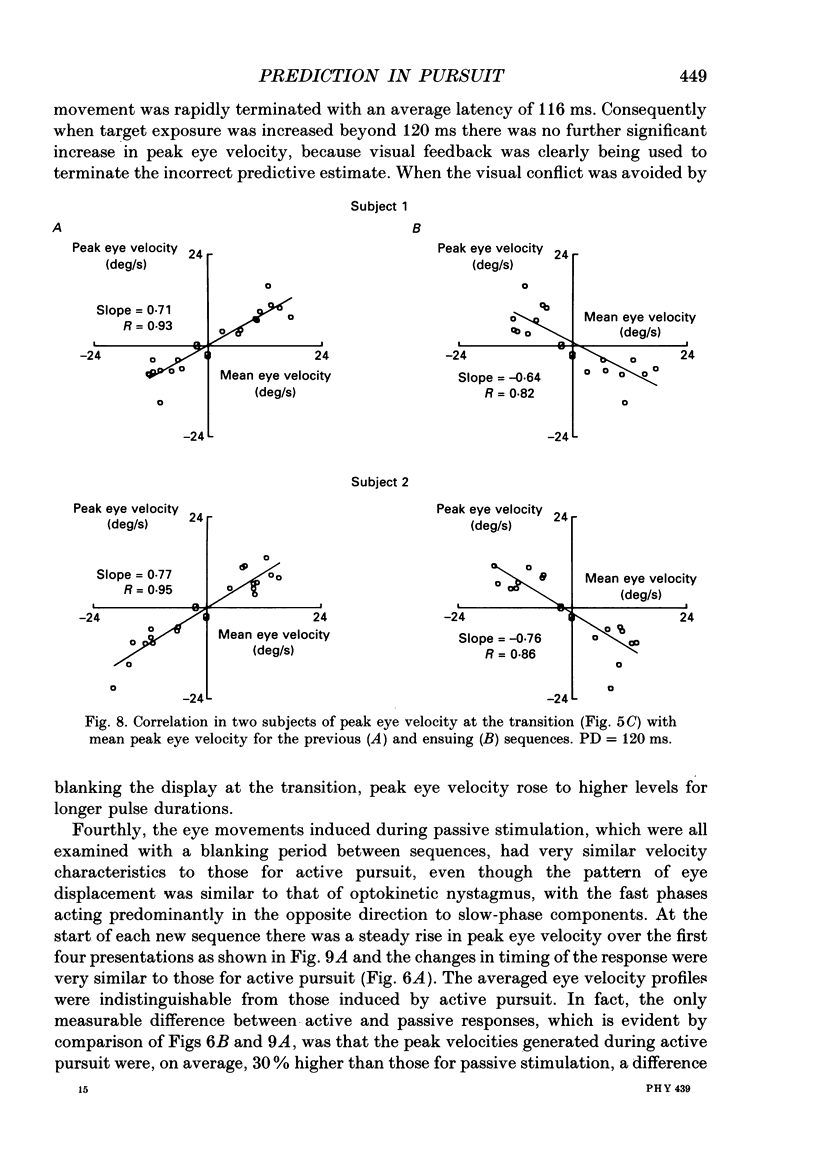
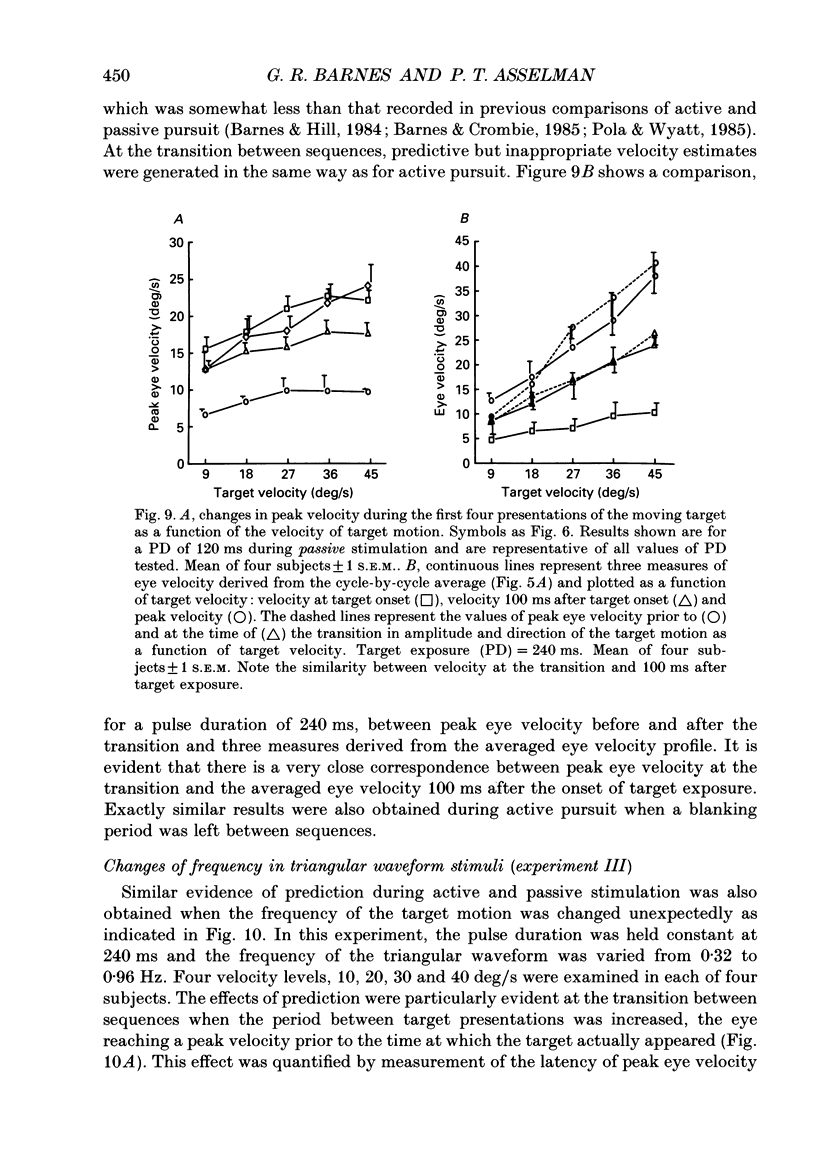
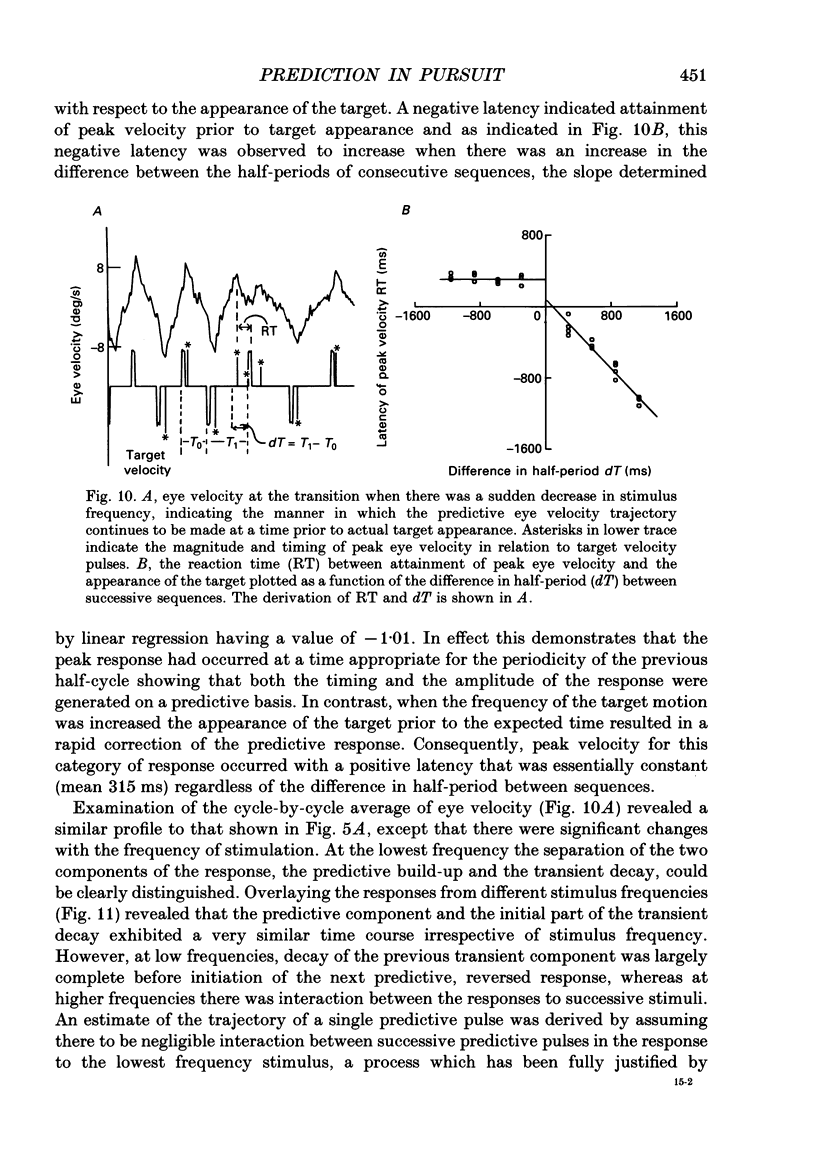
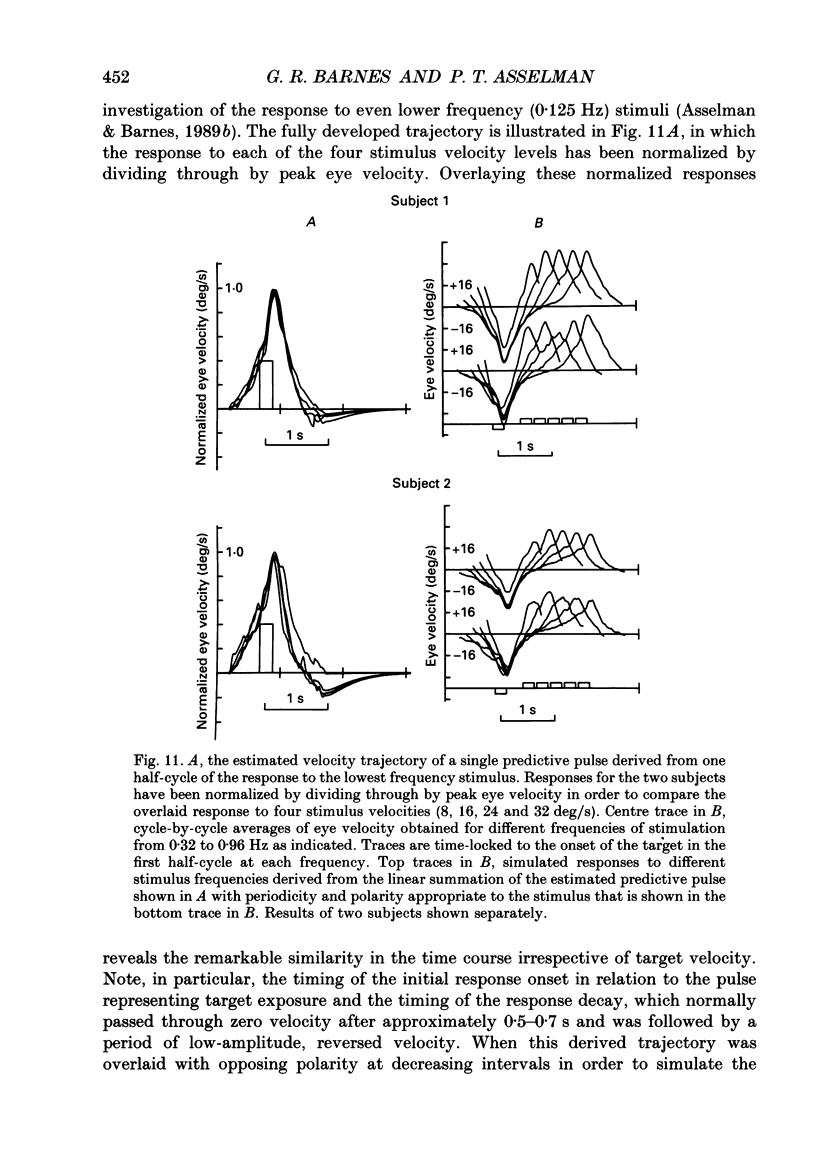
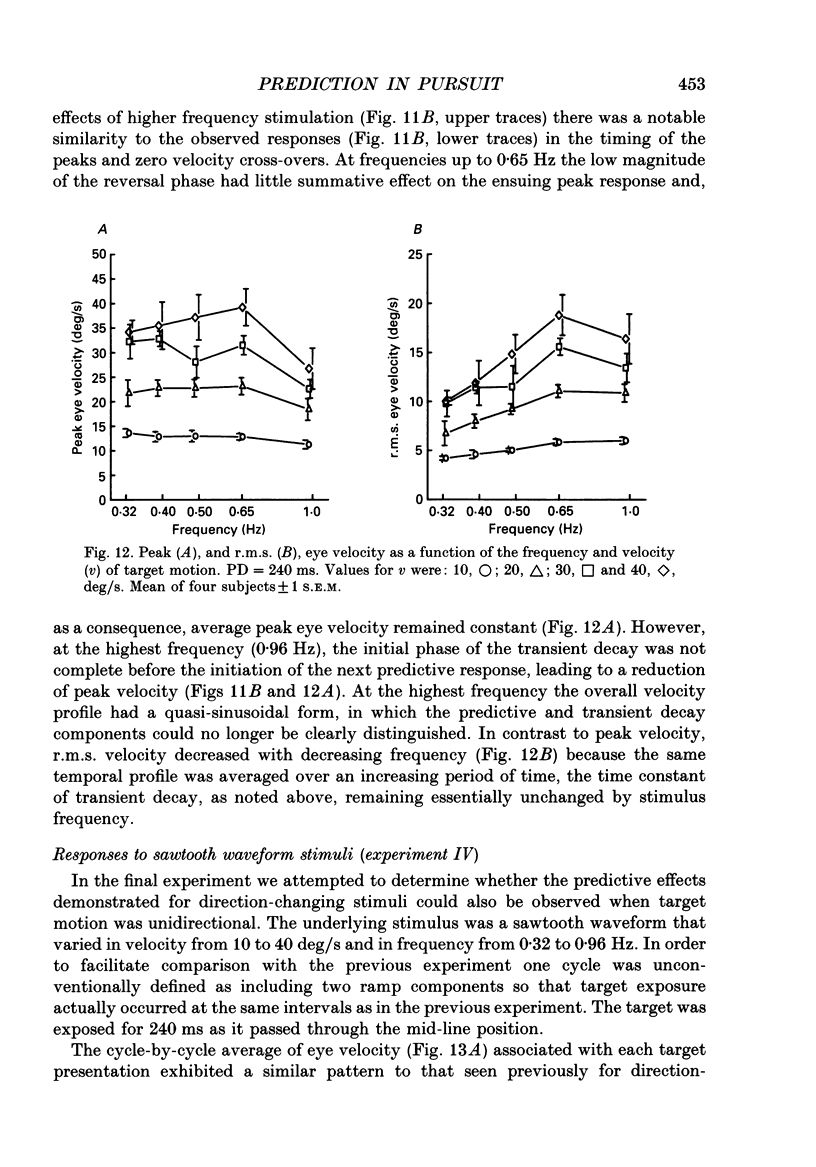
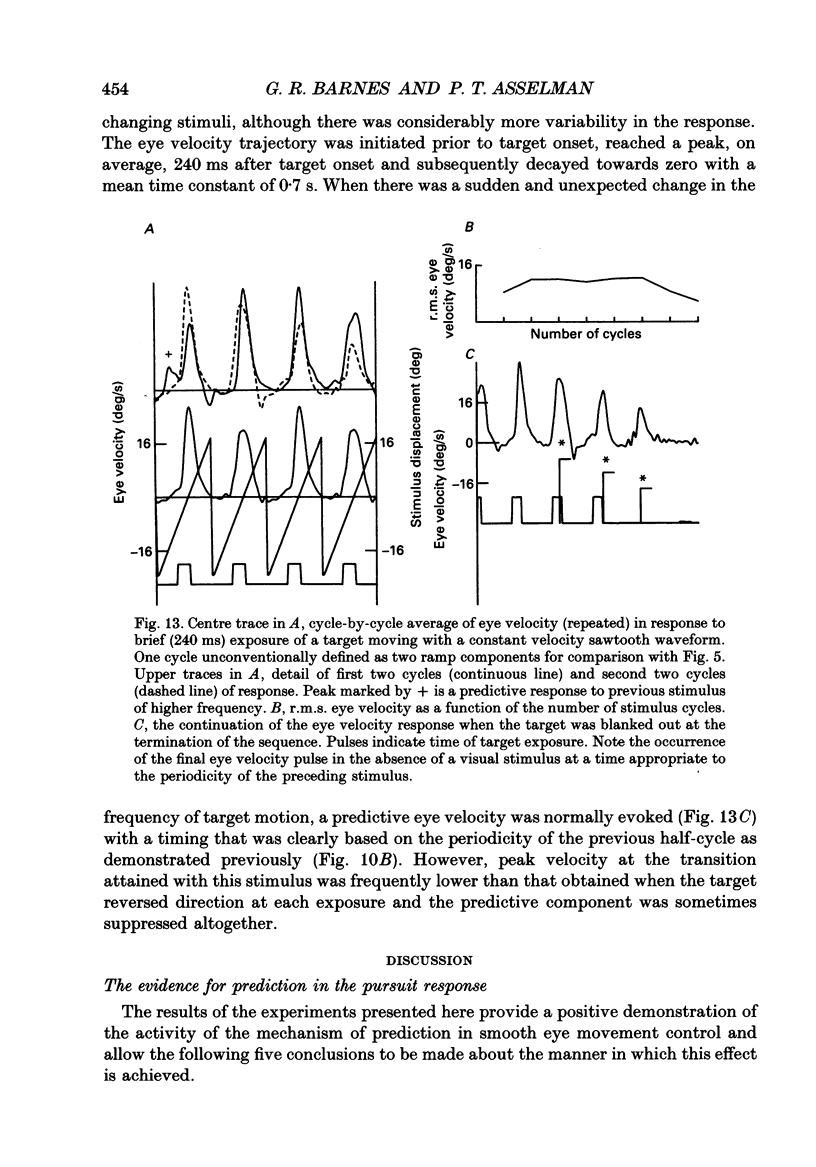
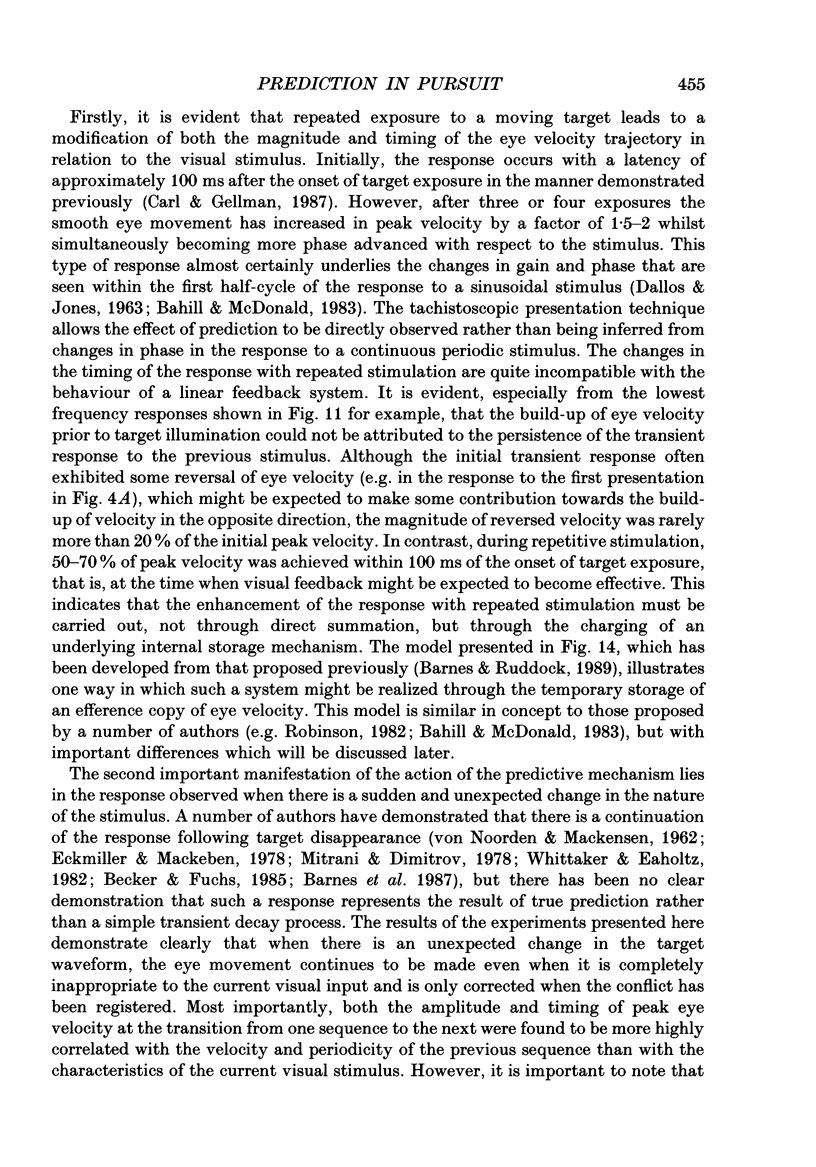
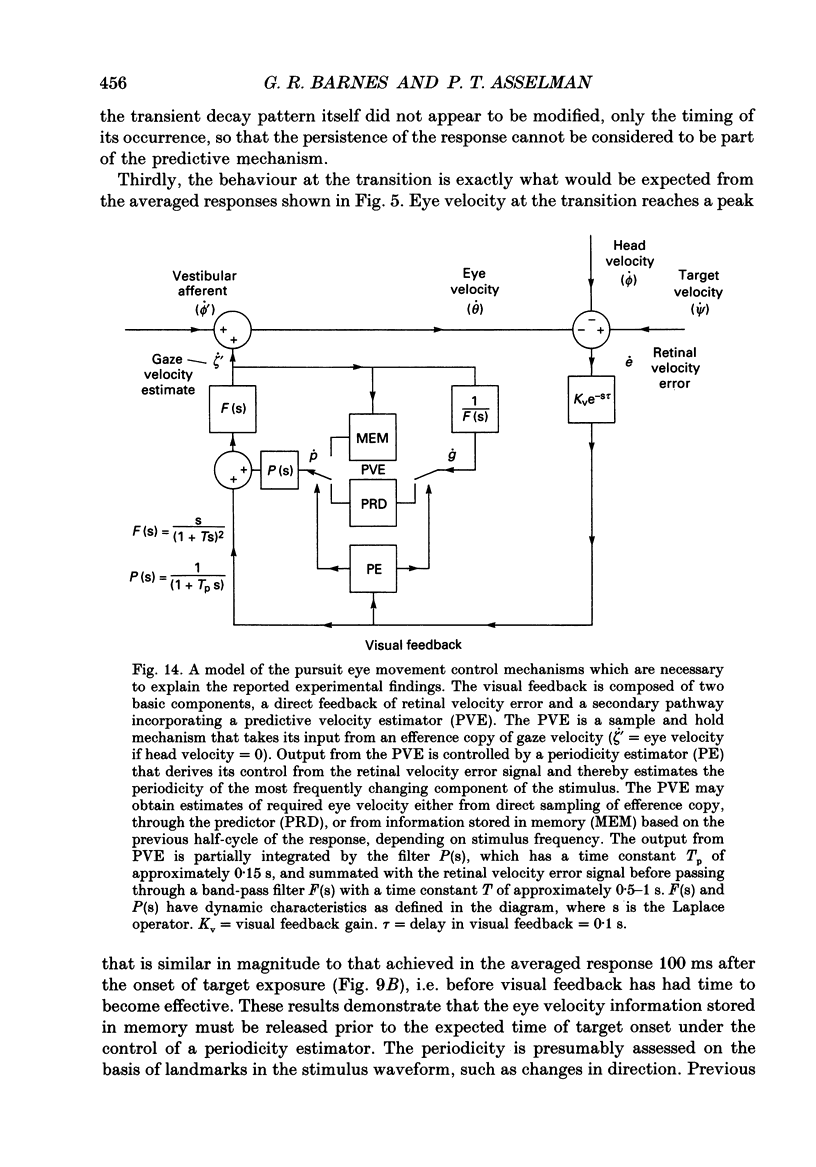
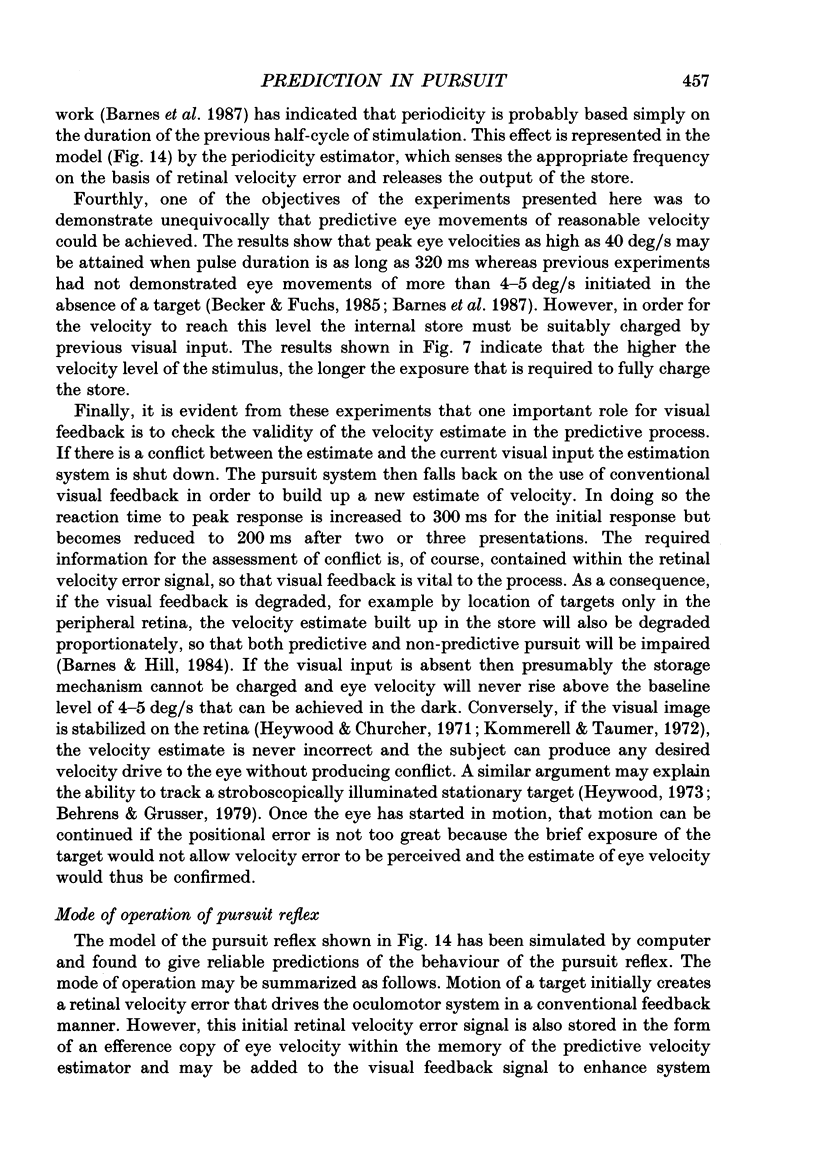
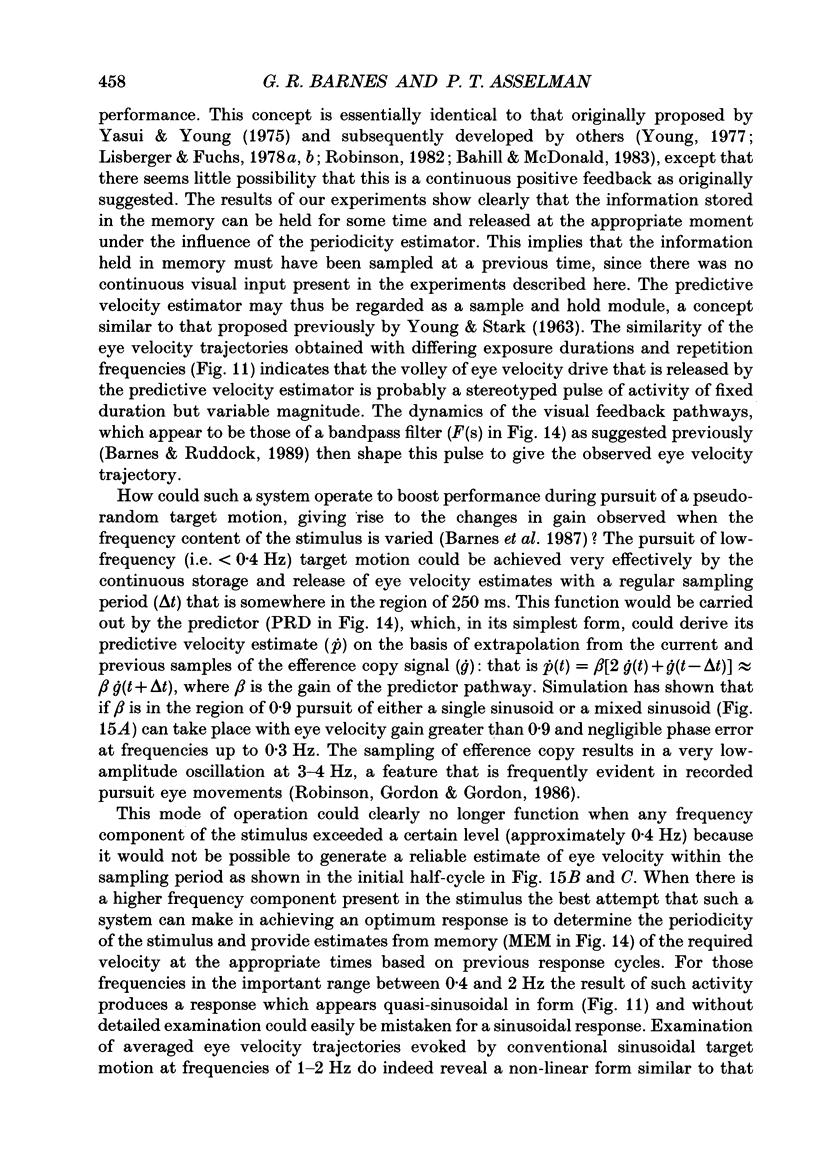
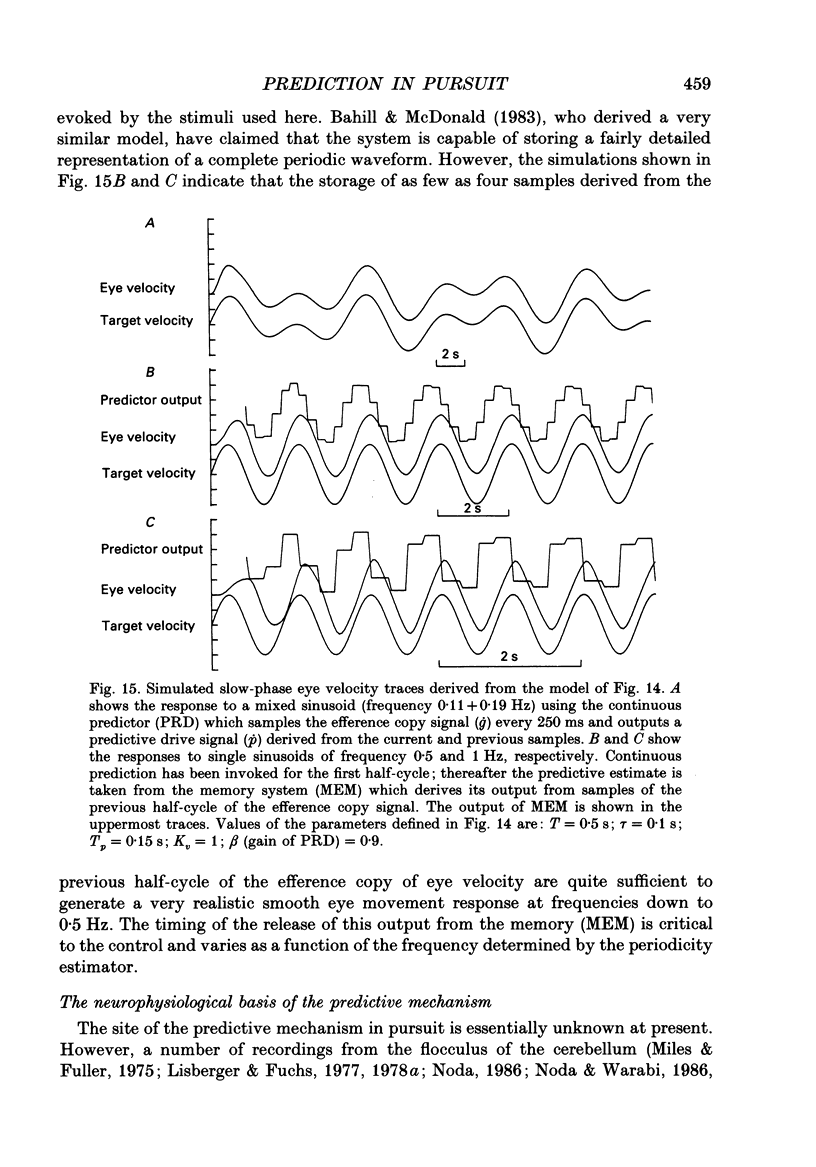
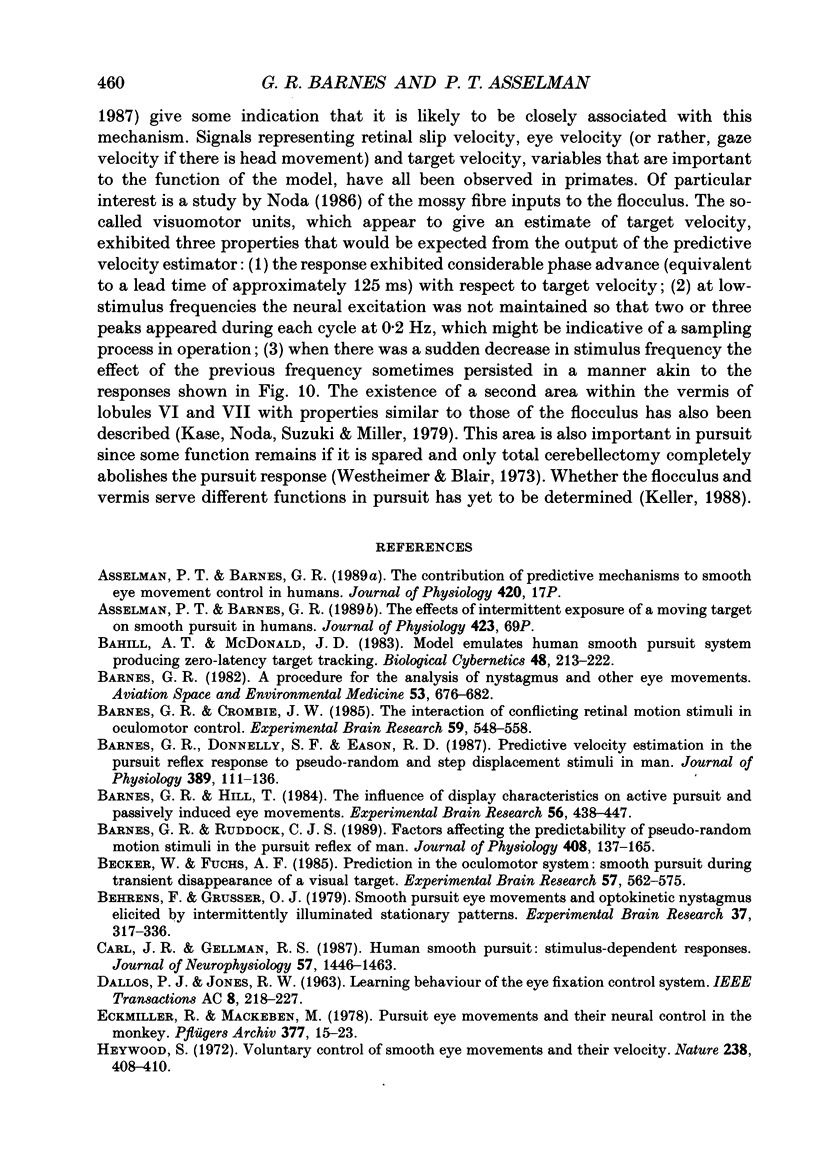
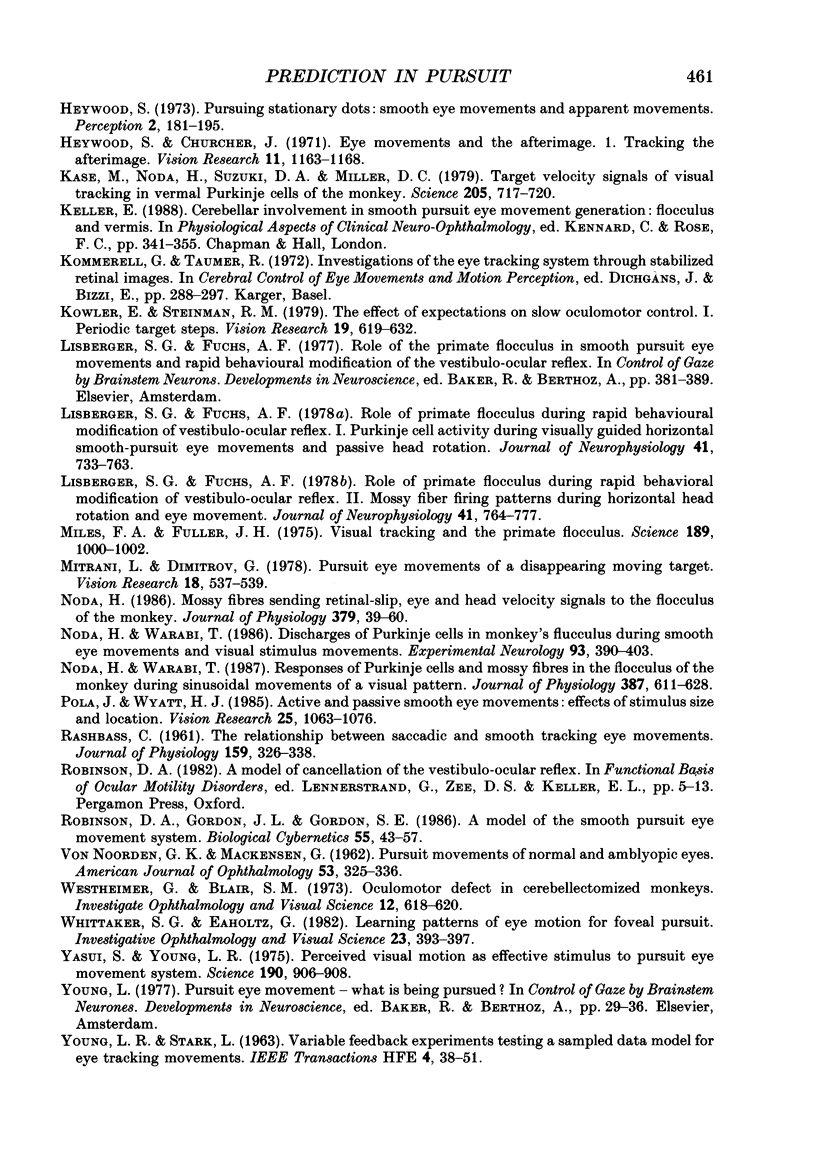
Selected References
These references are in PubMed. This may not be the complete list of references from this article.
- Bahill A. T., McDonald J. D. Model emulates human smooth pursuit system producing zero-latency target tracking. Biol Cybern. 1983;48(3):213–222. doi: 10.1007/BF00318089. [DOI] [PubMed] [Google Scholar]
- Barnes G. R., Crombie J. W. The interaction of conflicting retinal motion stimuli in oculomotor control. Exp Brain Res. 1985;59(3):548–558. doi: 10.1007/BF00261346. [DOI] [PubMed] [Google Scholar]
- Barnes G. R., Donnelly S. F., Eason R. D. Predictive velocity estimation in the pursuit reflex response to pseudo-random and step displacement stimuli in man. J Physiol. 1987 Aug;389:111–136. doi: 10.1113/jphysiol.1987.sp016649. [DOI] [PMC free article] [PubMed] [Google Scholar]
- Barnes G. R., Hill T. The influence of display characteristics on active pursuit and passively induced eye movements. Exp Brain Res. 1984;56(3):438–447. doi: 10.1007/BF00237984. [DOI] [PubMed] [Google Scholar]
- Barnes G. R., Ruddock C. J. Factors affecting the predictability of pseudo-random motion stimuli in the pursuit reflex of man. J Physiol. 1989 Jan;408:137–165. doi: 10.1113/jphysiol.1989.sp017452. [DOI] [PMC free article] [PubMed] [Google Scholar]
- Becker W., Fuchs A. F. Prediction in the oculomotor system: smooth pursuit during transient disappearance of a visual target. Exp Brain Res. 1985;57(3):562–575. doi: 10.1007/BF00237843. [DOI] [PubMed] [Google Scholar]
- Behrens F., Grüsser O. J. Smooth pursuit eye movements and optokinetic nystagmus elicited by intermittently illuminated stationary patterns. Exp Brain Res. 1979 Oct;37(2):317–336. doi: 10.1007/BF00237717. [DOI] [PubMed] [Google Scholar]
- Carl J. R., Gellman R. S. Human smooth pursuit: stimulus-dependent responses. J Neurophysiol. 1987 May;57(5):1446–1463. doi: 10.1152/jn.1987.57.5.1446. [DOI] [PubMed] [Google Scholar]
- Eckmiller R., Mackeben M. Pursuit eye movements and their neural control in the monkey. Pflugers Arch. 1978 Oct 18;377(1):15–23. doi: 10.1007/BF00584369. [DOI] [PubMed] [Google Scholar]
- Heywood S., Churcher J. Eye movements and the afterimage. I. Tracking the afterimage. Vision Res. 1971 Oct;11(10):1163–1168. doi: 10.1016/0042-6989(71)90120-9. [DOI] [PubMed] [Google Scholar]
- Heywood S. Voluntary control of smooth eye movements and their velocity. Nature. 1972 Aug 18;238(5364):408–410. doi: 10.1038/238408a0. [DOI] [PubMed] [Google Scholar]
- Kase M., Noda H., Suzuki D. A., Miller D. C. Target velocity signals of visual tracking in vermal Purkinje cells of the monkey. Science. 1979 Aug 17;205(4407):717–720. doi: 10.1126/science.111350. [DOI] [PubMed] [Google Scholar]
- Kommerell G., Täumer R. Investigations of the eye tracking system through stabilized retinal images. Bibl Ophthalmol. 1972;82:288–297. [PubMed] [Google Scholar]
- Kowler E., Steinman R. M. The effect of expectations on slow oculomotor control. I. Periodic target steps. Vision Res. 1979;19(6):619–632. doi: 10.1016/0042-6989(79)90238-4. [DOI] [PubMed] [Google Scholar]
- Lisberger S. G., Fuchs A. F. Role of primate flocculus during rapid behavioral modification of vestibuloocular reflex. I. Purkinje cell activity during visually guided horizontal smooth-pursuit eye movements and passive head rotation. J Neurophysiol. 1978 May;41(3):733–763. doi: 10.1152/jn.1978.41.3.733. [DOI] [PubMed] [Google Scholar]
- Lisberger S. G., Fuchs A. F. Role of primate flocculus during rapid behavioral modification of vestibuloocular reflex. II. Mossy fiber firing patterns during horizontal head rotation and eye movement. J Neurophysiol. 1978 May;41(3):764–777. doi: 10.1152/jn.1978.41.3.764. [DOI] [PubMed] [Google Scholar]
- Miles F. A., Fuller J. H. Visual tracking and the primate flocculus. Science. 1975 Sep 19;189(4207):1000–1002. doi: 10.1126/science.1083068. [DOI] [PubMed] [Google Scholar]
- Mitrani L., Dimitrov G. Pursuit eye movements of a disappearing moving target. Vision Res. 1978;18(5):537–539. doi: 10.1016/0042-6989(78)90199-2. [DOI] [PubMed] [Google Scholar]
- Noda H. Mossy fibres sending retinal-slip, eye, and head velocity signals to the flocculus of the monkey. J Physiol. 1986 Oct;379:39–60. doi: 10.1113/jphysiol.1986.sp016240. [DOI] [PMC free article] [PubMed] [Google Scholar]
- Noda H., Warabi T. Discharges of Purkinje cells in monkey's flocculus during smooth-pursuit eye movements and visual stimulus movements. Exp Neurol. 1986 Aug;93(2):390–403. doi: 10.1016/0014-4886(86)90199-8. [DOI] [PubMed] [Google Scholar]
- Noda H., Warabi T. Responses of Purkinje cells and mossy fibres in the flocculus of the monkey during sinusoidal movements of a visual pattern. J Physiol. 1987 Jun;387:611–628. doi: 10.1113/jphysiol.1987.sp016591. [DOI] [PMC free article] [PubMed] [Google Scholar]
- Pola J., Wyatt H. J. Active and passive smooth eye movements: effects of stimulus size and location. Vision Res. 1985;25(8):1063–1076. doi: 10.1016/0042-6989(85)90094-x. [DOI] [PubMed] [Google Scholar]
- RASHBASS C. The relationship between saccadic and smooth tracking eye movements. J Physiol. 1961 Dec;159:326–338. doi: 10.1113/jphysiol.1961.sp006811. [DOI] [PMC free article] [PubMed] [Google Scholar]
- Robinson D. A., Gordon J. L., Gordon S. E. A model of the smooth pursuit eye movement system. Biol Cybern. 1986;55(1):43–57. doi: 10.1007/BF00363977. [DOI] [PubMed] [Google Scholar]
- VON NOORDEN G. K., MACKENSEN G. Pursuit movements of normal and amblyopic eyes. An electro-ophthalmographic study. 1. Physiology of pursuit movements. Am J Ophthalmol. 1962 Feb;53:325–336. doi: 10.1016/0002-9394(62)91183-2. [DOI] [PubMed] [Google Scholar]
- Westheimer G., Blair S. M. Oculomotor defects in cerebellectomized monkeys. Invest Ophthalmol. 1973 Aug;12(8):618–621. [PubMed] [Google Scholar]
- Whittaker S. G., Eaholtz G. Learning patterns of eye motion for foveal pursuit. Invest Ophthalmol Vis Sci. 1982 Sep;23(3):393–397. [PubMed] [Google Scholar]
- Yasui S., Young L. R. Perceived visual motion as effective stimulus to pursuit eye movement system. Science. 1975 Nov 28;190(4217):906–908. doi: 10.1126/science.1188373. [DOI] [PubMed] [Google Scholar]


